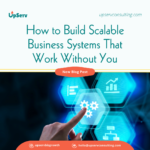Introduction: The Secret to a Business That Runs Itself
Every successful business reaches a point where growth slows—not because of a lack of opportunity, but because of inefficient processes and a heavy reliance on the business owner.
If your business can’t function smoothly without you, it’s time to rethink how you operate. The key? Process standardization and automation. These two pillars create a scalable system that allows your business to grow without your constant involvement.
In this guide, we’ll explore how to build scalable business systems that free up your time, increase efficiency, and improve profitability.

Step 1: Standardize Your Processes for Consistency and Efficiency
Imagine if every team member handled tasks their own way—chaos, right? Process standardization ensures consistency, minimizes errors, and improves efficiency. Here’s how to do it:
– Identify Repetitive Tasks
Write down all the recurring tasks in your business, from client onboarding to invoicing. These are the areas where standardization can bring immediate impact.
– Document Clear Standard Operating Procedures (SOPs)
A standardized system works when every step is clearly documented and easy to follow. Use tools like Notion, Google Docs, or Trainual to create SOPs.
– Train Your Team on SOPs
A system is only as good as the people using it. Schedule training sessions, record tutorial videos, and ensure your team follows the same structured approach.
Step 2: Automate to Reduce Manual Work and Save Time
Many businesses lose hours every week on tasks that could be automated. Here’s how you can leverage automation tools to scale smarter:
– Automate Customer Relationship Management (CRM)
Managing client interactions manually is inefficient. Instead, use CRM tools like Zoho, HubSpot, or Salesforce to:
- Track leads & follow-ups automatically
- Send pre-scheduled email sequences
- Personalize customer interactions without extra effort
– Automate Task & Project Management
Tools like Trello, Asana, or ClickUp help you:
- Assign tasks with deadlines automatically
- Keep track of project progress
- Eliminate the need for constant check-ins
– Automate Financial Processes
Why spend hours on invoices and payroll when tools like QuickBooks and Wave can handle them automatically? Automating your finances saves time and reduces errors.
– Automate Email & Marketing Campaigns
Stop manually sending emails and social media updates. Use tools like Zoho Campaigns, Mailchimp, or Buffer to:
- Schedule posts & emails in advance
- Run automated drip campaigns
- Segment audiences for personalized messaging
Step 3: Monitor, Optimize & Scale Your Systems
Your systems should evolve as your business grows. Here’s how to keep them effective:
- Track Performance: Use analytics tools to measure efficiency. Are your automation tools saving time? Are tasks getting completed faster?
- Gather Feedback: Ask your team where they experience bottlenecks. Continuous improvement is key.
- Refine & Upgrade: As new technologies emerge, adapt and optimize your processes to stay ahead.
Conclusion: Work Smarter, Not Harder
Building scalable business systems isn’t just about growth—it’s about freedom. By focusing on process standardization and automation tools, you create a business that thrives even when you’re not actively involved.
Learn how Upserv Consulting can help scale your business: https://upservconsulting.com/about-us/
Ready to implement systems that free up your time and scale your business? Book a FREE Business Efficiency Consultation today!
[https://calendly.com/upservconsultation/30min]
Let’s help you build a business that works FOR you, not the other way around.


